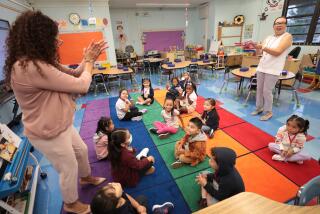‘Baby-Boom Echo’ Is Putting a Strain on Schools, Study Finds
WASHINGTON — Classrooms in California and across the nation will be more crowded than ever this fall, the result of a “baby boom echo” that shows no sign of abating, according to a Department of Education report released Thursday.
The increasing numbers of children of baby boomers, along with the children of immigrants, will continue to strain campuses and resources until more schools are built, according to department officials.
“Four years ago I described this enrollment as a long, slow rising wave,” said Secretary of Education Richard W. Riley. “Today, not only are we having a big wave, but also a rising tide. It is a permanent, constant lift in the number of children who are in the public and private schools of this nation.”
Enrollments in kindergarten through 12th grade, which have been increasing for 14 years, will hit a record 53.2 million in 1999, officials said. That figure will continue to grow until 2006, the report found, with the most rapid increases occurring in high schools, colleges and universities. About 1.3 million new students will enter high school in the coming decade, 261,000 of them in California, the largest increase in the nation.
Wendell Greer, principal of Los Angeles’ Manual Arts High School, said at a news conference here that his school’s population has grown from 2,000 students in 1994 to 4,000 this year and is projected to grow to 6,000 by 2006.
President Clinton joined Riley, Greer and school administrators from around the country in presenting the report, titled “The Baby Boom Echo: No End in Sight.”
Nationwide, the continuing crush of students will complicate efforts to reduce class sizes and intensify the demand for qualified teachers, some educators said.
“We need to continue to have outreach to schools because we are in the trenches and that’s where it starts,” Greer said. “You can have high expectations but you have to have facilities. You can have high standards but you need an area to grow.”
Western and southern states will continue to lead the nation in school enrollment increases, the report said. By 2009, the report projects, the number of students in 13 Western states will have increased about 36% over 20 years--twice the national average. For that same period, California enrollments will increase 35%.
In the last 10 years, enrollment in California schools grew about 26% to 6 million. In the next 10 years the rate of growth is expected to slow to 7%.
Clinton said that the increase in students can make America “bigger, stronger and more diverse,” but that educators and government officials must do more to meet the educational requirements. In the next fiscal year, Clinton’s proposed federal education budget would set aside money to renovate 6,000 schools, he said, and to continue his long-term plans to add 100,000 teachers in the lower grades.
The report estimated that public schools will need to hire 2.2 million teachers over the next decade to meet enrollment increases and replace teachers who retire or leave the profession for other reasons.
Nationwide, funding for school construction and modernization will total $19.5 billion this year and education officials stressed that those costs will continue to increase. The average age of a public school building is 42 years old. Last year the American Society of Civil Engineers gave school improvement efforts an “F” in its annual report card on the nation’s infrastructure.
Although the latest report focused on the effect of the “baby boom echo” on increasing enrollment, education officials said in interviews that a steady flow of children of immigrants, as well as rising birth rates, have added to the problem.
Clinton used Thursday’s announcement to reiterate his message of fiscal responsibility, and once again promised to veto the Republican tax plan that he said cuts the educational opportunities of low-income children in half.
Educators said that the report confirmed trends they have seen in their classrooms for years and that teacher and facility shortages will continue to worsen unless a higher priority is placed on education.
“We have a community that wants an increase in accountability and improvements in the qualifications of teachers and principals coming into the field,” said Susan Galletti, associate executive director of the American Assn. of School Administrators. “If we are going to increase the standards we are going to have to increase the value that we place on these teachers.”
Other educators added that for many young people, the teaching profession does not hold the attraction it did 25 years ago. Doug Stone, a spokesman for California’s Department of Education, said that the state faces a double dilemma of attracting new teachers and improving education resources.
Enrollment in Los Angeles Unified, with 750,000 students the third-largest school system in the country, will increase by 200,000 elementary and secondary students in the next six years, the Department of Education estimated. Ten additional high schools, with space for 37,000, will be needed to accommodate the influx, officials said.
(BEGIN TEXT OF INFOBOX / INFOGRAPHIC)
Baby Boomers’ Babies
The five states with the largest projected enrollment increases in public school, fall 1999 to fall 2009
Numbers in thousands
State: California
Additional students: 428
State: Texas
Additional students: 316
State: Arizona
Additional students: 119
State: Georgia
Additional students: 115
State: Illinois
Additional students: 60
Births in U.S., in millions
1957: 4.3
Sources: U.S. Department of Education, National Center for Education Statistics, Projections of Education Statistics to 2009; U.S. Department of Commerce, Bureau of the Cenus Population Projections of the United States by Age, Sex, Race and Hispanic Origin: 1995 to 2050
More to Read
Sign up for Essential California
The most important California stories and recommendations in your inbox every morning.
You may occasionally receive promotional content from the Los Angeles Times.










